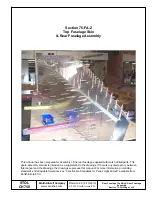
47
An alternative option to control the VOLT4 is to do it via the B-Risers
–
therefore is a handle
mounted at the B-riser.
When pulling down at this B-control the glider can be stabilized and actively flown. Like this the
glider can be kept on track or the glider can be controlled.
The advantage by using B-riser control compared to active flying by brakes is that the glider
loses less speed and performance.
It works throughout the whole speed range
–
also fully accelerated.
NOTE
: The use of B-riser control does not make the glider indestructible. It does not replace
proper active flying in strong turbulences.
g.
Accelerating
The speed system on the VOLT4
comes supplied with ‘quick hooks’ ready to attach to a speed
bar of choice. The complete speed system should be checked to ensure it runs smoothly by
hanging in the harness before flying.
In particular, check that the speed system won’t be engaged when in
normal flight.
Unnecessary knots and loops in a speed system are not recommended.
Modern 2-line paragliders like the VOLT4 showing a great stability also when accelerating. In
spite of the exceptional stability any accelerated collapse will be more dynamic than the same
event experienced at trim speed and will require quicker reactions to maintain normal flight.).
Always keep both hands on the controls when flying fast or in turbulence and be ready to
release the speed system immediately at the first sign of a collapse.
Use the speed system carefully when flying close to the terrain and maintain enough height
from the ground or other obstacles to recover in the event of a collapse.
DO NOT BRAKE WHILE FLYING FULLY ACCELERATED
–
THIS MAY RESULT IN A COLLAPSE OF THE
WING.
h.
Landing
The VOLT4 is easy to land, however, on your first flights you may be surprised at how well it
glides. Take account of this when making your landing approach and give yourself the
opportunity for S-turns or a longer approach than you might be used to.
For a normal, into-wind landing evenly pull the brakes all the way down when you are close to
the ground and straighten up to land on your feet. The glider will stop almost completely as the
brakes are fully applied. Avoid landing directly out of a turn or wing-over since the momentum
of the pilot will be much greater due to the pendulum effect.
Attention
:
After touching down do not allow the glider to dive overhead and fall in front of you. If the
leading edge hits the ground hard the structure of the cell walls may become damaged.
i.
Towing and winching
When towing or winching, the glider must be above the pilots head before starting.
In the initial phase the tension should not be too high
–
a pilot climbing at a flatter angle has
Summary of Contents for VOLT 4
Page 2: ...1 ...
Page 4: ...3 ...
Page 8: ...7 ...
Page 10: ...9 ...
Page 25: ...24 ...
Page 26: ...25 ...
Page 31: ...30 ...
Page 34: ...33 ...
Page 39: ...38 ...
Page 41: ...40 ...
Page 44: ...43 ...
Page 58: ...57 ...
Page 63: ...62 ...
Page 65: ...64 ...
Page 71: ...70 ...
Page 90: ...89 ...
Page 95: ...94 ...
Page 97: ...96 b Leinenplan Line Plan Plan de suspentage ...
Page 98: ...97 ...
Page 100: ...99 VOLT 4 XXS VOLT 4 XS VOLT 4 S VOLT 4 M VOLT 4 ML ...
Page 101: ...100 VOLT 4 TRAGEGURT RISER ELEVATEUR ...
Page 102: ...101 ...
Page 105: ...104 ...
Page 106: ...105 ...
Page 108: ...107 VOLT4 S ...
Page 109: ...108 ...
Page 110: ...109 ...
Page 111: ...110 ...
Page 112: ...111 ...
Page 113: ...112 ...
Page 116: ...115 Leinenplan Faltleinen Line Plan Folding Lines Plan de Lignes de Pliage ...
Page 120: ...119 ...
Page 121: ...120 ...
Page 122: ...121 ...
Page 125: ...124 ...
Page 128: ......
















































